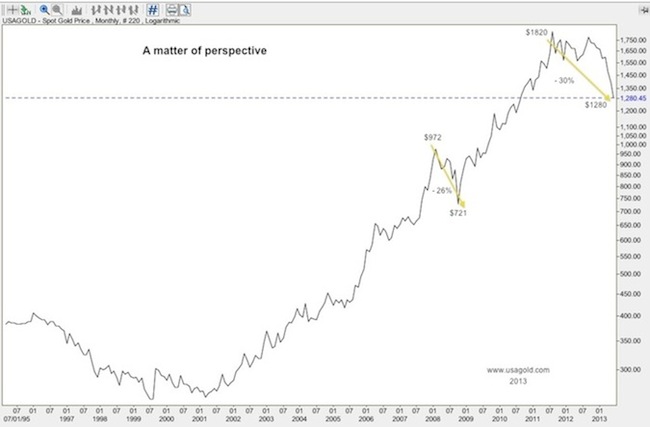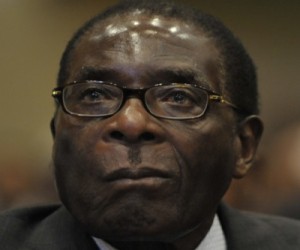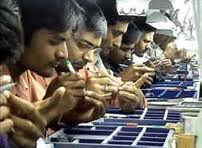
Bloomberg/Getty Images
In
1955, the Gemological Institute of America’s lab issued the first
diamond grading report, meant to serve as a third-party verifier that
would increase public confidence in the diamond industry. Yet in the years since, not everyone has maintained confidence in the system of grading labs and reports.
While
there are still many respected diamond-grading labs, others have earned
reputations for being overly generous in their evaluations. (And even
within that subgroup, there are those with reputations for being
somewhat generous, and others—one overseas lab, in particular—with a
reputation for being
really generous.) Within the gem trade,
talk abounds of varying lab standards; sometimes a branch of one lab
will be considered looser than another branch.
“The problem is as bad as I’ve ever seen it, and it’s not getting better,” complains Donald A. Palmieri, president of the Gem Certification and Assurance Laboratory (GCAL), a New York City–based lab.
 Courtesy of GIA
Courtesy of GIAA GIA diamond grader at work
Palmieri,
a frequent critic of his competitors, says he’s regularly asked by
dealers to evaluate diamonds a certain way to win their patronage. He
doesn’t take them up on it, but he believes that other labs do. “There
are a lot of labs out there that do what they have to do to get
business,” he says.
Mark Moeller, president of R.F. Moeller
jeweler, a three-store chain based in Minneapolis, says, “Diamond
grading is all over the map these days and it’s across-the-board.
 Courtesy of GIA
Courtesy of GIAA closeup of a 1.09 ct. round brilliant-cut diamond
“Everyone
is fighting over what the standard is,” he says. “How can you be
consistent with so many labs? The labs are just reacting to their
customers by being more lenient. It’s become a standing joke in the
industry: If you don’t like the grade, shave a point off and resubmit
it.”
The issue is so top of mind for members of the diamond trade
that Rapaport Corp. chairman Martin Rapaport has held three annual
forums on diamond certification at the JCK Las Vegas show; a fourth is
scheduled to take place at this year’s fair, on Sunday, June 2. At the
first forum, a jeweler asked attendees what she should do when a
customer comes in with a report from a lab she considers overly lenient
in its grading. She explained her conundrum by saying that she hates to
bash the competition, but also feels the person isn’t getting exactly
what they expect. No one knew how to answer her.
Moeller says he
grappled with this problem for some time. Eventually, he figured, “If
you can’t beat ’em, join ’em.” Tired of seeing his competitor win
customers with reports from a lab that he feels “grades to a more
lenient standard,” he started carrying reports from that lab as well.
“We
were losing a lot of sales,” he says. “And we only do it if everything
has truly failed and the customer is really just a price-shopper. So we
are honest: We explain to the customer that this grading is more
lenient. And usually they don’t care. If they want a 2 carat with an
$18,000 budget, am I supposed to send them walking?”
As an example, Moeller sent
JCK
two reports for the same 2 ct. stone: The report from AGS calls the
diamond a K VS1—about $11,200 on Rapaport. The other report, from the
“lenient lab,” calls it a J VVS2—about $14,000 on Rap. Stones with
reports from the lenient lab, however, carry as much as a 30 percent
discount compared with stones with reports from more respected labs,
leading consumers to feel they are getting a J VVS2 for a K VS1 price.
Part
of the problem is that diamond grading, by its nature, is subjective.
Sometimes even graders within the same lab will disagree about a call.
And with more stones getting reports, and labs getting larger and
opening more international branches, it can be hard to maintain
standards worldwide. (And some worry that inconsistent standards could
spread to the other important task labs perform: screening treatments
and synthetics.)
To determine just how much consistency there is among the industry’s varying reports,
JCK had a New York City dealer send the same diamond to a number of leading labs. (See chart.) Unlike a similar experiment
JCK
conducted in the mid-1990s—when a diamond received three different
grades from three different labs—the stone received virtually the same
grade from all four labs. Only one lab graded the color higher, but that
variation was within the generally accepted one-grade tolerance. (And
the dealer, naturally, said he agreed with the higher grade.)
LAB REPORT
JCK sent a round brilliant diamond in the 0.6 ct.–0.7 ct. range to four leading labs. Here are their grades: |
| Lab | Color | Clarity | Cut |
| International Gemological Institute | F | VS2 | Excellent, excellent |
| AGS Laboratories | F | VS2 | 0 cut grade |
| Gemological Institute of America | F | VS2 | Excellent cut grade |
| EGL USA | E | VS2 | Ideal Plus |
While
this is mostly an intratrade concern, it also has attracted
intermittent attention from the consumer media. A 2005 episode of
Dateline NBC
had a reporter buy from a leading retailer a diamond that was described
as flawless. When it was graded, it was found to be of a much lower
clarity. The report also found wider disparities in lab grading than
JCK did—with one diamond receiving multiple grades from the same organization.
Given
the importance of labs to the industry, how can the industry ensure
that the evaluators be more consistent—and accurate? There are several
schools of thoughts on this:
Grade the diamonds by machine.
 Courtesy of IGI
Courtesy of IGI Step up to the mic! An instructor guides IGI School of Gemology students through the grading process.
Machines
that automatically grade color—and to a lesser extent clarity—do exist,
and many labs use them. International Gemological Institute president
and CEO Jerry Ehrenwald predicted at the 2011 Rapaport forum in Las
Vegas that “within the next decade, we will have machines that can grade
color and clarity. And, eventually, that will wipe out all the labs.”
(Ehrenwald and others, however, note that grading labs will still be
needed to detect treated stones and synthetics.)
The Forevermark
is going this route. Stephen Lussier, CEO of the De Beers brand, which
is bucking convention by grading its own diamonds, says that it
regularly uses machines in its color evaluations.
“The machine is
currently our most reliable color grader,” he says. “One of the things
we have learned is that even the best human will only be right eight out
of 10 times when color grading. The eyes can’t see things the whole
day; that is why you need multiple opinions.”
He says the company
also is working on a device that will grade clarity. “Consistency is
most important for us,” he adds. “Grading is part science, part art. You
will never completely eliminate humans. But we are focused on
technology because humans are not infallible.”
GIA also uses a proprietary device “to some extent” in its color grading, says spokesman Stephen Morriseau.
American
Gem Society lab executive director Peter Yantzer says his lab used a
color-grading device for a while, but found it became less consistent
with use. But he thinks another possible answer is for all graded
diamonds to be photographed, along with a master set of color grades. A
computer or similar program then could match the diamond pictures to
the master set.
Enlist an independent organization to evaluate and certify the labs.
Associations
that evaluate and certify labs do exist and regularly evaluate labs
that look at things like food preparation and crime scenes. They are, in
a sense, third-party verifiers for the third-party verifiers. But few
in our industry take advantage of them. (One exception is GCAL, which is
certified by an organization called the Laboratory Accreditation
Bureau.)
There is also the International Standards Organization,
which has evaluated a number of industry labs, including IGI, HRD
Antwerp, and GCAL. The Tiffany Gemological Laboratory, which the
retailer uses to grade its own gems, also conforms to ISO standards.
Let the public know how the market views different reports.

In
many ways, the diamond market already has developed a market-based
solution: within the industry, certain “certs” are worth less than
others. For instance, the RapNet listing service found that certain
reports carried as much as a 30 percent price differential.
PolishedPrices.com publishes a similar evaluation on its site.
Yantzer
has called for these indexes to be made public to consumers; that is
how it’s done in coin grading, he explains: “All you have to do is go to
the online indexes and look at their prices. The industry adjusts
those prices based on the consistency and quality of the grading of the
lab. That is how the industry handles inaccurate grading. But
consumers don’t know this. And retailers tell them all labs are created
equal.
“This information needs to be published where consumers
can get access to it,” Yantzer says. “Sure, many consumers wouldn’t
care. But some of them would.”
Ensure that the labs offer guarantees.
Palmieri
believes that one solution is for labs to guarantee their grades, as
his does, with a “zero tolerance” guarantee. When GCAL was owned by
publicly listed Collector’s Universe, it guaranteed its findings within
the standard one-grade tolerance. Now the lab is no longer associated
with that company and it doesn’t even allow itself the one-grade
tolerance. “Why shouldn’t a lab have to stand behind its grades?”
Palmieri asks. “That’s what a retailer has to do.” (He admits that while
there are some stones that can be called “borderline,” that doesn’t
happen often and they can be marked as such.)
Yantzer says his lab
is considering a similar guarantee. “I think it’s possible to create a
true certificate,” he says, though his idea includes a one-grade
tolerance. The question for him would be who would determine the
ultimate accuracy of the grade. “You would have to have some group of
long-term graders,” he says.
Get industry associations to crack down.
At
his forum, Rapaport urged the industry to police labs that are
regularly more than one grade off. “We need to say, if you are two
colors off, that is not acceptable,” he says. And he speaks for many in
the industry when he says that the industry needs to seriously look at
what is being produced by its labs. “Right now,” he says, “there is no
red line.”


















 In
many ways, the diamond market already has developed a market-based
solution: within the industry, certain “certs” are worth less than
others. For instance, the RapNet listing service found that certain
reports carried as much as a 30 percent price differential.
PolishedPrices.com publishes a similar evaluation on its site.
In
many ways, the diamond market already has developed a market-based
solution: within the industry, certain “certs” are worth less than
others. For instance, the RapNet listing service found that certain
reports carried as much as a 30 percent price differential.
PolishedPrices.com publishes a similar evaluation on its site.
